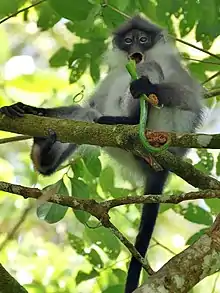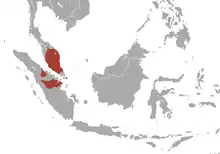White-thighed surili
The white-thighed surili (Presbytis siamensis) is a species of primate from the family of old world monkeys (Cercopithecidae). This species lives arboreal amongst the sub-montane forests.[2] It is endemic to the Thai-Malay Peninsula, the Riau Archipelago and Sumatra.[1] In addition, the white-thighed surili contain four subspecies: siamensis (nominate), cana, paenulata and rhionis, are recognized here.[3] Furthermore, they are characterized by the white patches located on the outside of their legs, which is what gives them their name.[4] Additionally, they can be referred to as pale-thighed langur/surili.[4] These primates are an important species for the diversity of forest environments in the Malaysian area.[5]
| White-thighed surili | |
|---|---|
 | |
| On Pahang, Malaysia | |
| Scientific classification | |
| Domain: | Eukaryota |
| Kingdom: | Animalia |
| Phylum: | Chordata |
| Class: | Mammalia |
| Order: | Primates |
| Suborder: | Haplorhini |
| Infraorder: | Simiiformes |
| Family: | Cercopithecidae |
| Genus: | Presbytis |
| Species: | P. siamensis |
| Binomial name | |
| Presbytis siamensis | |
 | |
| White-thighed surili range | |
Description
Physical
The white-thighed surili are made up of a common surili build, ranging from around 41–69 cm tall and weighing 5–6.7 kg.[4] Their slender build is covered with a brown-grey fur coat on their backs, with white fur covering their bellies and dark fur on their head.[4] They are known for the white fur on the outsides of their thighs (giving them their name).[4] Additionally, their tails – typically covered in dark fur – can extend roughly 58–85 cm.[4] Compared to adults, infants are born with very light fur with crosses of dark fur along their arms and back.[4]
Habitat
As an arboreal species, P. siamensis live in subtropical/tropical forest environments. They have been found to occupy moist lowland or swamp areas.[1] In fact, they can even be inhabitants of terrestrial environments; for example, rural gardens.[1] They can be located mainly on the Malay Peninsula, but are also found in Sumatra, as well as some parts of Thailand.[1]
Social organization
The white-thighed surili live in small unimale-multifemale groups.[6] After mating, females give birth to single infants to which the group of females care for.[6] Due to their arboreal lifestyle, reliance on detection of predators is vital. Male group members are able to call or display a distraction for predators to protect group members.[6] Furthermore, this predator avoidance strategy is shown to be more effective with smaller groups.[6]
Taxonomy
P. siamensis is a member of old world monkeys. P. siamensis itself contains four subspecies: siamensis, cana, paenulata, and rhionis.[1] Research suggests the white-thighed surili includes P. natunae (Natuna Island surili) as a subspecies; however both have been considered subspecies of P. femoralis (Banded surili).[3] Alternatively, research suggests three species are endemic to Malaysia: P. siamensis, P. femoralis and P. robinsoni (Robinson's Banded langur).[2] Through mitochondria DNA analysis, these three species are split into two separate clades: P. femoralis on its own, P. robinsoni and P. siamensis in the other.[2] This was due to the sharing of unique nucleotides between P. robinsoni and P. siamensis.[2] There continues to be ongoing evolution of Robinson's banded langur and the white-thighed surili.[2]
Research suggests that P. femoralis was the basal lineage of Presbytis in peninsular Malaysia.[7] It was hypothesized that P. femoralis diverged to form P. robinsoni and P. siamensis.[7] The movement of P. femoralis to the Malaysian peninsula created the allopatric distribution.[7] Further dispersal on the peninsula itself resulted in the divergence of P. robinsoni and P. siamensis through allopatric speciation.[7] Overall, the taxonomy is constantly evolving and in need of continuing research.[1][8][9]
Threats
According to the IUCN Red List, the current status of the white-thighed surili is near threatened.[1] Researchers say several Presbytis species are affected by logging activities, although not all of them are recognized on the IUCN red list.[10]
Conservation efforts for non-human primates - such as the white-thighed surili - are valued significantly. This species is seen in the public's eye as a value of science, genetics, forest sustainability, aesthetic, tourism, and a symbol of heritage.[11] Researchers suggest continuing to familiarize the public with primate conservation concerns to enhance the willingness of participate in conservation efforts.[11] In addition, only 30% of the forested area on the Malaysian Peninsula is legally protected from resource extraction, leaving 70% of forests vulnerable.[5] More research on abundance, ecology and behavioural biology of the white-thighed surili is vital to creating better conservation management plans.[5]
An alternative threat to this species has nothing to do with logging. Sometimes these primates may be kept as pets or used in the entertainment industry.[5] Currently this species is listed under Appendix II of the Convention on International Trade in Endangered Species (CITES) to protect them from this.[1] Moreover, education the public on illegal trade of primates as pets may combat the demand for the industry.[5]
References
- Ang, A.; Traeholt, C. (2020). "Presbytis siamensis". IUCN Red List of Threatened Species. 2020: e.T18134A17953755. doi:10.2305/IUCN.UK.2020-2.RLTS.T18134A17953755.en. Retrieved 15 November 2021.
- Vun, V.F.; Mahani, M.C.; Lakim, M.; Ampeng, A.; Md-Zain, B.M. (2011). "Phylogenetic relationships of leaf monkeys (Presbytis; Colobinae) based on cytochrome b and 12S rRNA genes". Genetics and Molecular Research. 10 (1): 368–381. doi:10.4238/vol10-1gmr1048. PMID 21365553.
- Groves, C. P. (2005). Wilson, D. E.; Reeder, D. M. (eds.). Mammal Species of the World: A Taxonomic and Geographic Reference (3rd ed.). Baltimore: Johns Hopkins University Press. p. 172. ISBN 0-801-88221-4. OCLC 62265494.
- "White-thighed surili videos, photos and facts – Presbytis siamensis". Arkive. Retrieved 4 April 2020.
- Lappan, S; Ruppert, N (2019). Research and Conservation.pdf "Primate research and conservation in Malaysia" (PDF). CAB Reviews: Perspectives in Agriculture, Veterinary Science, Nutrition and Natural Resources. 14 (4): 1–10. doi:10.1079/PAVSNNR201914004. S2CID 92124559.
{{cite journal}}: Check|url=value (help) - Nijman, V; Nekaris, K.A.I (2012). "Loud Calls, Startle Behaviour, Social Organisation and Predator Avoidance in Arboreal Langurs (Ceropithecidae: Presbytis)". Folia Primatol. 83 (3–6): 274–287. doi:10.1159/000339647. PMID 23363588. S2CID 18747217.
- Abdul-Latiff, M.A.B; Baharuddin, H; Abdul-Patah, P; Md-Zain, B.M. (2019). "Is Malaysia's banded langur Presbytis remoralis femoralis, actually Presbytis neglestus neglectus? Taxonomic revision with new insights on the radiation history of the Presbytis species group in Southeast Asia" (PDF). Primates. 60 (1): 63–79. doi:10.1007/s10329-018-0699-y. PMID 30471014. S2CID 53712933.
- Brandon-Jones, D., Eudey, A. A., Geissmann, T., Groves, C. P., Melnick, D. J., Morales, J. C., Shekelle, M. and Stewart, C.-B. 2004. Asian primate classification. International Journal of Primatology 25(1): 97–164.
- Ang, A.; Roesma, D.I.; Nijman, V.; Meier, R.; Srivathsan, A. & Rizaldi (2020). "Faecal DNA to the rescue: Shotgun sequencing of non-invasive samples reveals two subspecies of Southeast Asian primates to be Critically Endangered Species". Scientific Reports. 10 (1): 9396. Bibcode:2020NatSR..10.9396A. doi:10.1038/s41598-020-66007-8. PMC 7287133. PMID 32523128.
- Lammertink, M; Nijman, V; Setiorini, U (2003). "Population size, Red List status and conservation of the Natuna leaf monkey Presbytis natunae endemic to the island of Bunguran, Indonesia". Oryx. 37 (4): 472–479. doi:10.1017/S003060530300084X.
- Mutalib, A.H.A; Fadzly, N; Kamaruszaman, S.A (2017). "A brief study on public's perception, knowledge and willingness to participate in primate conservation". Malayan Nature Journal. 69 (4): 369–381 – via Research Gate.
